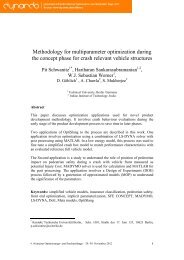multiPlas - Dynardo GmbH
multiPlas - Dynardo GmbH
multiPlas - Dynardo GmbH
You also want an ePaper? Increase the reach of your titles
YUMPU automatically turns print PDFs into web optimized ePapers that Google loves.
3.3.2 MOHR-COULOMB isotropic yield criterion<br />
Fig. 3-3 MOHR-COULOMB isotropic yield criterion<br />
The yield criterion is:<br />
where:<br />
⎛ sinΘ<br />
sinϕ<br />
⎞<br />
= σ sinϕ<br />
+ σ<br />
⎜<br />
⎜cos<br />
Θ −<br />
⎟ − c cosϕ<br />
⎝<br />
3 ⎠<br />
F m S<br />
(3-11)<br />
σx<br />
+ σy<br />
+ σz<br />
σ m =<br />
(3-12)<br />
3<br />
σ = I<br />
(3-13)<br />
S<br />
σF<br />
-σ1<br />
-σ3<br />
2<br />
3 3 I3<br />
sin( 3 Θ ) = − 3 2<br />
(3-14)<br />
2 I<br />
2<br />
σ1 = σ2 = σ3<br />
σm hydrostatic stress<br />
I2 second invariant of the deviatoric main stresses<br />
I3 third invariant of the deviatoric main stresses<br />
Θ Lode-angle<br />
-σ2<br />
-σ3<br />
Θ = - 30° Θ = 30° compressive meridian (Θ = 30°)<br />
ϕ tensile meridian (Θ = - 30°)<br />
-σ2 -σ1<br />
C<br />
τ<br />
σM<br />
10<br />
These yield criteria depend only on the two<br />
material parameters:<br />
cohesion c and<br />
inner friction angle ϕ<br />
USER’S MANUAL, January, 2013






